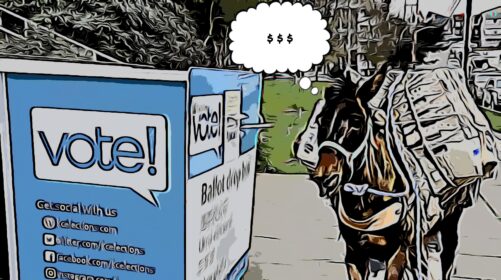Most security measures in place are to prevent interference from the public. There is little in place to ensure the public that the elected officials cannot interfere with the process, and even more worrisome, the vendors who sold the equipment to the county. There is remote access available to election offices in case there are any hiccups or if for some reason they need tech support. There are multiple layers of possible unauthorized, and authorized access, which are unknown to the average person.
The software has several features to allow someone with access the ability to change any voter’s information within the system, add and delete voters, change their address, their mailing address, and even their vote. They can inactivate voters in bulk, reactivate, move, and override any information within the records.
Out of date policy
The policies governing the election process have not been regularly evaluated or updated to reflect the growth rate of technological advancements and their availability to the public. As our knowledge and understanding grows, so does the risk of intrusion. In general, cybersecurity methods evolve as people learn new ways to gain unauthorized access. It’s a constant battle.
Election equipment is stored by the county auditor year-round. The auditor, who is in charge of the election for their county, is the one who choses and purchases the equipment used to conduct elections. Access to the equipment is limited to certain staff and should be monitored.
Logic and Accuracy

Before the start of each election, the equipment undergoes a test which is referred to as a “logic and accuracy test.” Interestingly, it tests and proves neither logic nor accuracy. It is just a step they go through so they can claim they did it. Then they can tell us that because they did it, everything is secure. This “test” is done at the county elections office while the SOS is present.
How it “Works”
To conduct the test, there is a controlled batch of ballots, for which they know the results already. The ballots are fed through the scanner/tabulator one time. The results reported by the machine is compared to the results of the controlled batch of ballots. If the totals match, the test is over, and the equipment is ready to go for the next election.
It wouldn’t take long for someone with any access to be able to alter the accuracy of the machine’s counting or reporting settings. A USB thumb drive containing a counting program could be inserted and automatically installed anytime. This would be difficult to detect under the current testing standards. Another possibility is that someone could connect to the system remotely, or without physical access to the equipment if they already have established a backdoor.

There are several ways it can be done; these are just some basic examples. For us to trust that it would never happen is naive. There are many reasons our election systems would become a target. There is also plenty of motivating factors. Even by those who are tasked with protecting it.
Post-Election Audit
In Washington State, immediately after the election, there is a “Random Batch Audit” performed on a small number of ballots (300 in most counties), to supposedly ensure accuracy. This procedure is as in depth as the logic and accuracy tests. The problem is that these tests aren’t really designed to catch fraud as ballots could be possibly pre-selected or even counterfeit. We also learned that some (possibly all) counties only count the ballots scanned after 8pm on election day, meaning they don’t even look at the early ballots.
Risk Limiting Audit
WA State has just finished a pilot program in 9 counties implementing “Risk Limiting Audits” (RLA). According to the WA SOS, a RLA is a post-election audit that ensures election results match what the voters selected. Problem being is that there is an algorithm in the RLA software program called Arlo that has all the ballot images from the election. The software program tells the elections officials which ballots to pull to “audit” the election.
In November of 2019, the US Department of Homeland Security announced it would partner with Voting Works to Pilot the use of its vote verification software in six battleground states during the November 2020 election. Arlo is touted to see if the outcome of an election is statistically likely and is being promoted through Voting Works (a 501 non-profit).
Voting Works was created by the left-leaning Center for Democracy and Technology (CDT), a major donor is George Soros through his Foundation to Promote Open Society. THESE ARE MOST OBVIOUSLY SHAM AUDITS AS THE HUMAN ELEMENT IS NOW COMPLETELY GONE!
Comparing Audits
WHAT IS WORSE IS THAT IN WASHINGTON STATE the plan is to replace the current “Random Batch Audits” (which still has some human element) with the new “Risk Limiting Audits.” Depending on how close the election is (only about 1/10 of 1% of election results are checked). Ballot images from the election are used to determine which ballots the election officials are to select to verify the election is accurate.
Thurston County election observers in a recent RLA reported that in a Nov 2021 election of 60,000 votes counted, only about fifty (50) ballots were checked via the RLA Arlo program. If elections have predetermined outcomes via computer algorithms like many have proven and believe (Jovan Pulitzer, Dr. Frank, Draza Smith, David Clements and others) than the RLA could easily be “rigged audits” and part of a cover up for the election as the human element is now completely taken out of the equation.
I-1505 Voter Protection Act
There is a citizen’s initiative that would provide a more comprehensive audit of the ballots. It’s called the Voter Protection Act (I-1505) and would call for a bipartisan audit of the ballots before the election is certified. We recommend everyone sign this initiative to help voters regain confidence in our election process.
This measure came from the Skagit County Republican Party Election Integrity Committee, ended up in the Washington State Republican Party Election Integrity Committee and required months of meetings and planning.
Key Points of the Voter Protection Act
- I-1505 will require the two major political parties in each county to cooperate with important election audits.
- Audits are performed by county election officials.
- An independent company with experience in the election process and/or professional auditing shall be chosen by the parties to oversee the audits.
- If the parties can’t agree on the company, then the county canvassing board decides.
- Republican and Democrat County Party leadership agree on at least 3 races and/or ballot measures, with each party choosing 6 voting precincts for each General Election. If the parties can’t agree, then the company will choose.
- The audits are “statistically significant” hand counts of all paper ballots tabulated in 12-voting precincts (before election certification).
- As an example, Garfield County only has 12 voting precincts, so an audit of this type would be an entire re-count in each race (assuming each race includes the 12-voting precinct county threshold).
- If a county has an election with less than 12 precincts, then it does not qualify for this type of audit.
- The entire 12-precinct vote totals must be no less than 5% of the total county vote count for each of the individual races.
Read the Full Text
I-1505 Frequently Asked Questions
Why isn’t the company performing the audits? To keep the cost down. To get support for the measure and for it to become law, cost was considered to be an important factor.
Why aren’t the audits done for the primary elections? To keep the cost as minimal as possible.
Why aren’t races of less than 12 voting precincts allowed? To keep it easier to administer and to focus on races that are the most likely to be of significance and discoverable.
Why We Need Better Audits
The Washington State Constitution Art 1 Sec. 19 Freedom of Elections says All Elections Shall Be Free and Equal. Accurate vote counts of all legal ballots are important for free and accurate elections, and are essential to fair, transparent and honest elections.
Voter confidence and voter trust of our elections systems are at all time historic lows. Over the course of decades our national and state election process has shown various public officials’ enacted laws, ordinances, rules, and regulations run contrary to liberty and freedom, especially in elections.
The current Washington State auditing method of elections systems of Risk Limiting Audits and Random Batch Audits are insufficient, and the number of ballots audited is not statistically significant to be considered true “audits.”
The Citizens’ Initiative I-1505 “The Voter Protection Act” will help to restore voter confidence and faith in our elections by ensuring an accurate vote count, and that only legitimate votes are counted in Washington State elections with full transparency and oversight.




